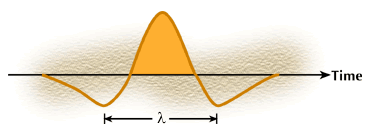 |
 |
| ©2000 AGI |

The dominant wavelength associated with a seismic wavelet is defined as the distance between two identical phase points of an oscillating function, as shown in Figure 1 below.

Figure 1. Definition of dominant wavelength. Wavelength is the distance between two identical phase points on an oscillating function. Typically wavelength is measured between adjacent peaks or troughs as shown by the symbol
above. This seismic wavelet contains a wide spectrum of wavelengths, but the wavelength that is most apparent is the one shown by
, this it is called the dominant wavelength.
Typically,
wavelength is measured between adjacent peaks or troughs by the symbol
l. This seismic wavelet contains a wide spectrum of wavelengths, but the
wavelength that is most apparent is the one shown by ![]() ;
thus it is called the dominant wavelength.
;
thus it is called the dominant wavelength.
A thin
bed is a stratigraphic unit that has a thickness much less than
the dominant wavelength of the seismic wavelet that illuminates the bed.
It is generally accepted that if ![]() is the dominant wavelength of the illuminating seismic wavelet, then a
thin bed is a bed with a thickness that is one-fourth of
is the dominant wavelength of the illuminating seismic wavelet, then a
thin bed is a bed with a thickness that is one-fourth of ![]() or less. It is important to note that the definition of a thin bed depends
on the length of the investigative wavelength. A bed that is thin relative
to a low-frequency (long-wavelength) wavelet may not be thin when a higher
frequency (shorter wavelength) wavelet is considered, as is illustrated
in the following figure.
or less. It is important to note that the definition of a thin bed depends
on the length of the investigative wavelength. A bed that is thin relative
to a low-frequency (long-wavelength) wavelet may not be thin when a higher
frequency (shorter wavelength) wavelet is considered, as is illustrated
in the following figure.
Figure 2. Relationship between dominant wavelength and seismic thin beds. Thin beds are units that have thicknesses that do not exceed one-fourth of the dominant wavelength. A reservoir that is a thin bed when illuminated by a low-frequency wavelet (right) may not be a thin bed when illuminated by a high-frequency wavelet (left)